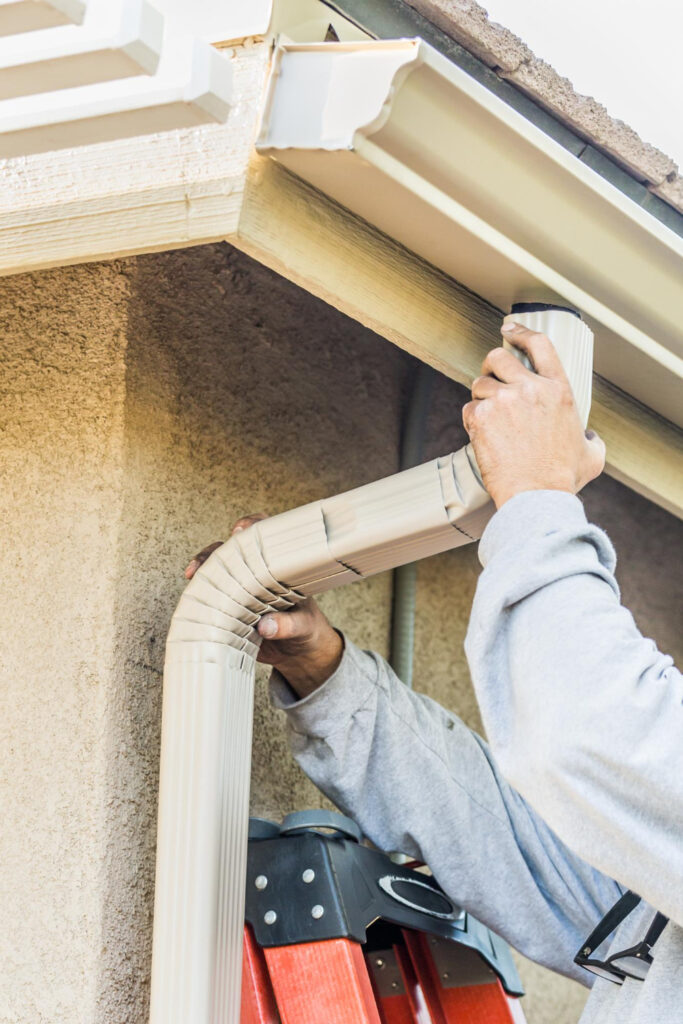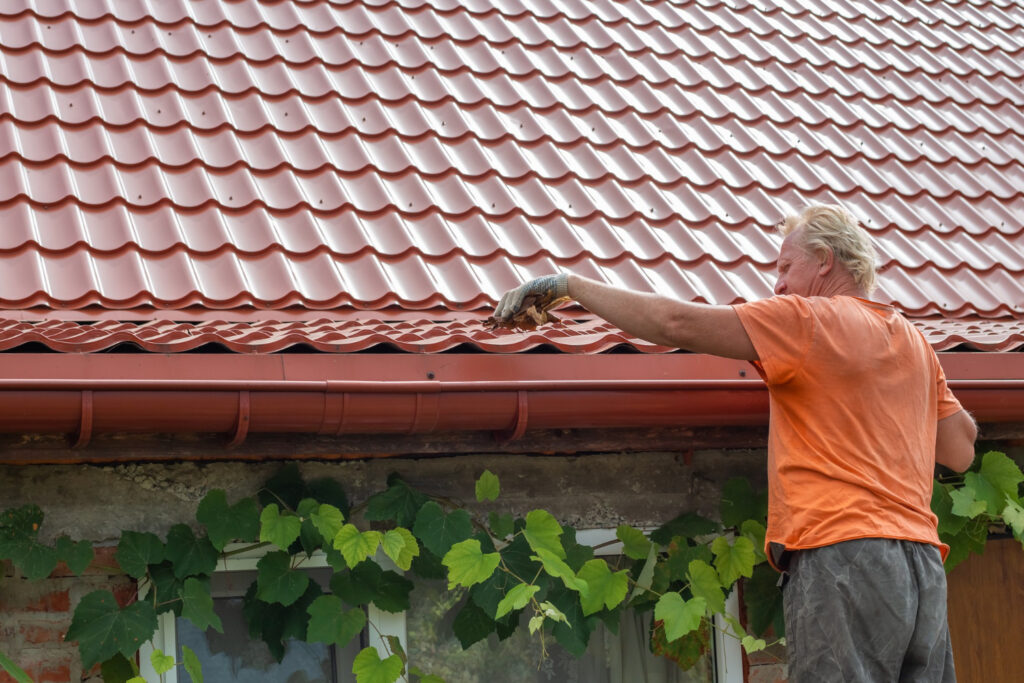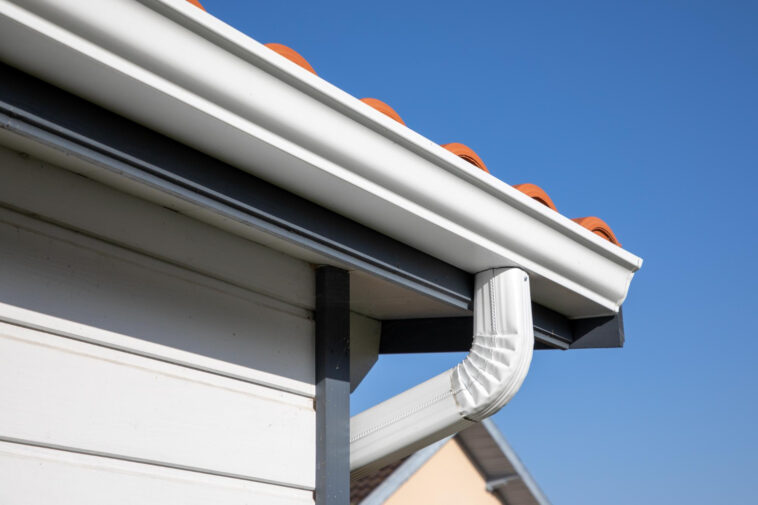Can You DIY Gutters
Protecting my home from water damage is a top priority, and I know that gutters play a crucial role in achieving this. They help keep rainwater away from my roof and foundation, which can save me from expensive repairs in the long run. While it's common to hire a professional gutter installer, I've been curious about whether I can tackle this project myself.
In this comprehensive guide, I'll explore the possibilities and provide you with a step-by-step tutorial on both gutter installation and maintenance. By the end, I hope to have a better understanding of whether DIY gutter work is suitable for my home and my skill level.
Gutter Installation
Tools and Materials
Embarking on a DIY gutter installation project requires meticulous planning and the acquisition of the right tools and materials to ensure a successful outcome. The following comprehensive list outlines the essential items you'll need:
Tools:
- Ladder: Safety should be a top priority, and a sturdy ladder is indispensable for reaching and working on your gutters securely.
- Tape Measure: Accurate measurements are crucial for proper gutter installation, ensuring a precise fit and optimal functionality.
- Chalk Line: Use a chalk line to create clear guidelines on your fascia or roof for precise gutter placement, ensuring that they are level and correctly aligned.
- Hacksaw: You'll need a hacksaw to cut gutter sections to the exact lengths required for your project.
- Screwdriver: An assortment of screwdrivers will be needed for attaching various components, such as hangers and downspouts.
- Rivet Gun: A rivet gun is essential for securely fastening gutter parts together, ensuring they stay in place even in adverse weather conditions.
- Caulking Gun: You'll require a caulking gun for applying sealant to prevent leaks at joints and seams, enhancing the longevity of your gutter system.
- Level: To guarantee that your gutters have the appropriate slope for effective water flow and drainage.
- Tin Snips: These are useful for making precise cuts in gutter sections, especially when dealing with corners and angles.
- Drill: A drill is a necessary tool for creating holes in your fascia or roof for screws and other fasteners.
- Safety Gear: Always prioritize safety by wearing safety glasses and gloves to protect yourself from potential hazards during the installation process.
Materials:
- Gutter Sections: Select the appropriate length and style of gutter sections based on the dimensions of your roof and the volume of rainfall in your area. Ensure you have enough to cover the entire roofline.
- Downspouts: Choose the suitable downspout size and style that will effectively channel rainwater away from your roof and foundation.
- Elbows and Connectors: These components allow you to create necessary angles and connections, ensuring the seamless flow of water within your gutter system.
- Gutter Hangers: Ensure you have an adequate quantity of gutter hangers to provide sturdy support for the entire length of the gutters, preventing sagging or detachment.
- Screws: Opt for stainless steel or zinc-coated screws, as they are corrosion-resistant and ideal for securely attaching gutters and their accessories.
- Gutter Sealant: Invest in a high-quality gutter sealant to prevent potential leaks at joints and seams, maintaining the integrity of your gutter system.
- Splash Blocks: These essential components should be placed at the end of downspouts to guide rainwater away from your home's foundation, preventing erosion and potential water damage.

Planning and Measurement
To lay the groundwork for a successful DIY to install gutters, meticulous planning and precise measurements are of paramount importance. Neglecting this crucial phase can result in costly errors down the road. Here's an in-depth guide on how to approach the planning and measurement stage:
Step 1: Roofline Measurement
Initiate your project by undertaking a meticulous measurement of the entire roofline where the gutters will be installed. This initial step serves as the foundation for your project, and the accuracy of your measurements is pivotal. Using a reliable tape measure, ensure that you record the precise dimensions. Overlooking any protrusions, corners, or nuances in your roofline can lead to complications during the installation phase.
Step 2: Calculating Gutter Length
Armed with your accurate measurements, proceed to calculate the total length of gutter sections required. It's prudent to slightly overestimate this figure to account for any unforeseen variances or future adjustments. Running short of gutter material can be a substantial setback, and having a surplus ensures you're well-prepared for the installation.
Step 3: Strategic Downspout Placement
Next, strategize the placement of downspouts. Choose their locations with care, aiming for optimal efficiency in water drainage. Downspouts should be positioned at intervals that facilitate proper rainwater diversion away from your home's foundation. Take into account factors such as the volume of rainfall in your area and the layout of your property.
Step 4: Marking the Proper Slope
To ensure effective water flow towards the downspouts, employ a chalk line to mark a guideline that establishes the necessary slope. This slope should typically be around ¼ inch for every 10 feet of gutter. Adequate slope guarantees that rainwater swiftly finds its way to the downspouts, preventing overflow and potential damage to your property.
Explore our latest post on How to Caulk Anything
Gutter Installation Steps
Now that you've meticulously prepared with the right tools, materials, and a well-thought-out plan, it's time to delve into the actual installation process. Follow these comprehensive and detailed steps to ensure a successful DIY gutter installation:
Step 1: Install Gutter Hangers
Initiate the installation by affixing the gutter hangers along the previously marked chalk line. Ensure that they are evenly spaced and precisely aligned. The correct placement of these hangers is essential as they provide the necessary support for your gutters, preventing sagging and ensuring longevity.
Step 2: Cut Gutter Sections
With your precise measurements in mind, employ a hacksaw to cut the gutter sections to fit precisely between the hangers. Take your time during this step to achieve accurate cuts, as the alignment of the gutter sections is crucial to the overall functionality of your gutter system.
Step 3: Attach Elbows and Connectors
If your gutter system necessitates bends or angles to accommodate your roofline's configuration, utilize elbows and connectors to create the necessary configurations. These components are integral in ensuring the smooth flow of water through your gutters, preventing blockages and overflow.
Step 4: Install Downspouts
Position the downspouts at the predetermined locations and securely attach them to the wall using brackets. Confirm that the downspouts are correctly sloped to facilitate efficient water drainage away from your home's foundation. Proper downspout placement is pivotal in preventing water-related damage.
Step 5: Test for Proper Slope
Before finalizing the installation, employ a level to verify that the gutters have the appropriate slope for water flow towards the downspouts. Adjust as needed to achieve the correct angle, as this ensures effective drainage and prevents water accumulation.
Step 6: Seal Joints
Generously apply gutter sealant to all joints and seams. This step is indispensable in preventing leaks that could potentially lead to water damage and compromise the functionality of your gutter system. Adequate sealing enhances the durability of your installation.
Step 7: Secure the Gutters
Utilize screws to firmly secure the gutter sections to the hangers. Ensuring a secure attachment is crucial to prevent sagging or detachment, especially during heavy rainfall or snowfall. A robust attachment enhances the gutter system's resilience.
Step 8: Install Splash Blocks
Conclude your installation by placing splash blocks at the termination points of the downspouts. These blocks redirect rainwater away from the foundation of your home, effectively safeguarding your property against water-related damage.
Safety Considerations
Prioritizing safety is paramount when engaging in gutter installation. To safeguard yourself throughout the project, it's imperative to adhere to a comprehensive set of safety considerations:
Ladder Safety
Select a sturdy ladder with anti-slip features that provide stability and support when ascending to work at heights. Ensure the ladder is in excellent condition, free from defects, and capable of bearing your weight along with any tools or materials you may need to carry.
Secure Ladder Placement
Pay meticulous attention to the placement of the ladder. It should be positioned on a stable and level surface, free from any potential hazards that could compromise stability. Take extra care when setting up the ladder on uneven terrain or soft ground to prevent tipping or slipping.
Appropriate Safety Gear
Prior to starting the project, don the appropriate safety gear as a protective shield against potential hazards. Essential safety equipment includes:
- Gloves: High-quality gloves offer protection against sharp edges and prevent cuts or abrasions during handling of tools and materials.
- Safety Glasses: Wear safety glasses to shield your eyes from debris, dust, or any other flying particles that may be generated during the installation process.
Height Safety Awareness
Exercise heightened caution when working at elevated heights. Ensure you maintain your balance and stability, especially when handling tools, materials, or fasteners. Be mindful of your surroundings and any potential hazards that could lead to slips, trips, or falls.
Tool and Material Handling
Handle tools and materials with care and precision. Maintain a firm grip on tools to prevent accidental drops or mishaps. When working at heights, use tool belts or secure containers to keep essential items within easy reach and minimize the risk of accidents caused by dropping tools.
Explore our latest post on Repair Gutters
Gutter Maintenance
Why Regular Gutter Maintenance Is Essential
Before embarking on the specifics of gutter maintenance, it's vital to grasp the fundamental reasons behind the essentiality of keeping your gutters in impeccable condition. Regular maintenance isn't merely a chore; it's a proactive measure that can save you from potential costly repairs and safeguard your home's structural integrity.
Gutter maintenance serves several critical purposes, each contributing to the overall well-being of your home:
Preventing Clogs:
Gutters are susceptible to accumulating leaves, twigs, and debris over time. These accumulated materials can swiftly lead to clogs, obstructing the free flow of rainwater. Clogs not only impair the functionality of your gutters but also increase the risk of overflowing, potentially causing water damage to your home's exterior and foundation.
Avoiding Water Damage:
Clogged or damaged gutters can become pathways for water to infiltrate your home's foundation or walls. Over time, this water intrusion can lead to structural issues, including weakened foundations, mold growth, and rotting of wooden elements in your home's structure. Regular gutter maintenance is an effective preventive measure against these potential disasters.
Protecting Landscaping:
Well-maintained gutters play a vital role in preserving the integrity of your landscaping. By directing rainwater away from your home's foundation and the surrounding soil, gutters prevent erosion and shield plants, shrubs, and flowerbeds from damage. This, in turn, maintains the aesthetic appeal and value of your property's exterior.
Preventing Ice Dams:
In colder climates, clogged gutters can contribute to the formation of ice dams on your roof during winter. Ice dams can cause extensive damage, including roof leaks, water seepage, and compromised insulation. Regular gutter maintenance helps prevent the conditions that lead to ice dam formation, safeguarding your home from winter-related issues.

Tools and Materials
To ensure the efficient upkeep of your gutters, it's essential to have a well-equipped toolkit and the necessary materials. Here's a detailed list of the tools and materials you'll require:
Tools:
- Ladder: A secure and sturdy ladder is a non-negotiable tool for accessing your gutters safely. Ensure it's in good condition and positioned correctly.
- Gloves: Protect your hands from debris and sharp edges by wearing durable gloves throughout the maintenance process.
- Safety Glasses: When working above your head, safeguard your eyes with safety glasses to shield them from any falling particles or debris.
- Scoop or Trowel: These tools are indispensable for efficiently removing leaves, twigs, and other debris that may have accumulated within the gutters.
- Garden Hose with a Nozzle: Employ a garden hose with an adjustable nozzle to flush out any remaining debris and assess the gutters' water flow. It aids in identifying potential clogs and issues.
- Gutter Brush or Scrub Brush: For tackling stubborn residue or stains within your gutters, a specialized gutter brush or a scrub brush can be invaluable.
- Bucket: Keep a bucket handy for collecting debris and transporting tools while you work. This minimizes the need for multiple trips up and down the ladder.
Materials:
- Gutter Sealant: It's prudent to have gutter sealant on hand for minor repairs that may become evident during the maintenance process. Addressing leaks promptly can prevent more extensive damage in the future.
- Gutter Guards: While considered optional, gutter guards are an investment that can significantly reduce the frequency of gutter cleaning by preventing the accumulation of debris. Installing gutter guards can be particularly advantageous if your area experiences heavy leaf fall or frequent clogs.
Explore our latest post on DIY Repair Parts
Cleaning and Maintenance Steps
Now that you comprehend the critical importance of regular gutter maintenance, let's delve into the comprehensive steps required for cleaning and preserving the functionality of your gutter system:
Step 1: Prioritize Safety
Safety must be your foremost concern throughout the maintenance process:
- Set up your ladder on a stable and level surface, ensuring it's securely positioned.
- Safeguard your eyes by wearing safety glasses to shield them from potential debris.
- Protect your hands with sturdy gloves to prevent injury or discomfort during the cleaning process.
Step 2: Clear Debris
Utilize a scoop or trowel to meticulously and systematically remove leaves, twigs, and other accumulated debris from the gutters. Start from one end and methodically work your way to the other, leaving no section unattended. This thorough cleaning is essential to prevent clogs and maintain proper water flow.
Step 3: Check for Leaks
While engaged in the cleaning process, take the opportunity to inspect the gutters for visible leaks or holes. Address minor leaks promptly with gutter sealant to prevent further damage. For more extensive damage, it may be necessary to seek professional repairs to ensure the gutter system's effectiveness.
Step 4: Flush the Gutters
Following debris removal and leak assessment, employ a garden hose with an adjustable nozzle to flush out the gutters. This step serves a dual purpose: it ensures unobstructed water flow through the system and uncovers any hidden clogs that may have eluded your initial cleaning efforts.
Step 5: Scrub and Clean
For stubborn residue or persistent staining, employ a dedicated gutter brush or scrub brush to perform a thorough cleaning. Pay special attention to areas where water might have pooled, as these zones are particularly susceptible to debris buildup. A meticulous cleaning enhances the gutter system's longevity and functionality.
Step 6: Install Gutter Guards
Consider the installation of gutter guards if you wish to reduce the frequency of cleaning. Gutter guards serve as an effective barrier, preventing leaves and debris from entering the gutters. This optional addition simplifies maintenance and ensures that your gutter system remains efficient, particularly in areas with heavy leaf fall or frequent clogs.
Frequency of Gutter Maintenance
Determining how often to perform gutter maintenance hinges on various factors, such as your geographical location and the vegetation surrounding your property. The following considerations offer a more detailed perspective on the optimal frequency of gutter maintenance:
Location-Specific Variables:
The frequency of gutter maintenance varies based on where your home is situated. Consider the following:
- Urban vs. Rural: Urban areas may have less debris and vegetation, reducing the need for frequent cleaning. Conversely, rural or heavily wooded areas may require more regular maintenance due to an increased influx of leaves and debris.
- Climate: Regions with distinct seasons may necessitate more frequent gutter maintenance, especially in areas with harsh winters or intense rainy seasons.
General Maintenance Schedule:
As a general guideline, it's advisable to clean your gutters at least twice a year. These typically coincide with the spring and fall seasons. Seasonal cleanings help prevent issues before they escalate and ensure your gutter system functions optimally year-round.
Factors Indicating More Frequent Cleaning:
You may need to schedule more frequent gutter maintenance if you encounter the following circumstances:
- Overhanging Trees: If your property boasts trees with overhanging branches that shed leaves and debris, you're likely to face increased gutter clogs. In such cases, quarterly or even monthly cleanings may be necessary.
- Heavy Rainfall or Storms: Areas prone to heavy rainfall, storms, or torrential downpours can experience rapid debris buildup in gutters. In such instances, consider more frequent inspections and cleanings, particularly during the rainy season.
- Ongoing Issues: If you notice persistent problems like clogs, overflowing gutters, or water damage between your scheduled cleanings, it's imperative to address these issues promptly. Frequent gutter assessments and maintenance may be required to rectify these issues.
Conclusion
In response to the question, “Can you DIY gutters?”—the answer is a resounding yes. Gutter installation and maintenance are manageable DIY projects with the right tools, materials, and knowledge. By following the detailed steps provided in this guide, you can save money and ensure your home is protected from water damage.
However, it's essential to recognize your limitations and when to call in professionals, especially for complex installations or if you lack the necessary experience. Ultimately, the decision to DIY your gutters should align with your comfort level and the specific needs of your home.
Remember, regular maintenance is key to the longevity and functionality of your gutter system. By investing time in cleaning and upkeep, you can enjoy a dry and well-protected home for years to come.
Sources
https://www.bluebarrelsystems.com/blog/diy-gutters-downspouts/
https://myguttergnome.com/blog/gutter-installation/common-diy-gutter-installation-mistakes/
https://www.thisoldhouse.com/gutters/21016457/how-to-install-rain-gutters




